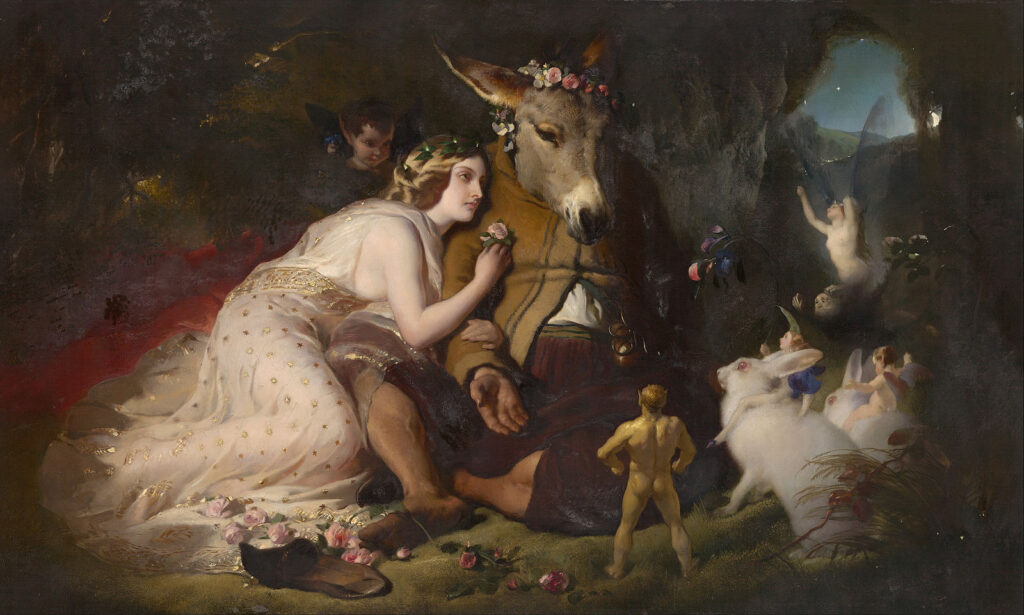
On the 400th anniversary of Shakespeare’s death, A Midsummer Night’s Dream seems to be the play of the moment. Emma Rice, the Globe Theater’s third Artistic Director, used Midsummer as the opener for her first summer season on April 30, and a month later the BBC premiered a new film adaptation directed by David Kerr and written by Russell T. Davies, better known to most as the helmsman of the revival of Doctor Who.
At first glance these productions are strikingly different: both modernize the play, but while Rice updates the locale to present-day London, her production chock-full of references to “Hoxton hipsters” rather than “Athenian youth,” Kerr instead transports his viewers to an Athens that looks and operates more like the Third Reich. Both adaptations, however, make the same choice to recast central characters as queer—Rice offering us a gay “Helenus” in place of Helena and an arguably closeted and in-denial Demetrius, while Kerr and Davies finish off their film (spoilers!) with a controversial and triumphant lesbian kiss between Titania and Hippolyta.
Just why does A Midsummer Night’s Dream lend itself so well to queer reinterpretations?
The best explanation may lie with the potent love potion secreted from the “little western flower” that blossoms at the heart of the play’s wild reversals and reconstructions of affection. Although Shakespeare himself limited his matchmaking to opposite-sex couples, he also provides technically no rules about the limitations of this potion’s abilities, as perhaps evidenced by his flower-fueled amour between a woman and a donkey. Now production after production has at last begun to examine just what A Midsummer Night’s Dream says about the arbitrariness of love, and expanded it to its natural conclusions. This, too, is what many viewers of such productions have termed (often derogatorily) “political correctness”—but whether the concept of love as utterly arbitrary is actually politically correct or simply another way of undermining inherent sexuality may be a question best left for another day.
The Globe’s adaptation is nothing if not modern—a fact that has garnered its fair share of controversy. Vivid artificial lighting floods the stage, jubilant pop music abounds, Hermia and Helenus take a minute off to the side to dance ecstatically to Beyoncé’s “Single Ladies.” Lysander’s t-shirt bears a Jack Kerouac quote reading, eminently appropriately: “I have nothing to offer the world but my confusion.”
But perhaps the most modern aspect of the play is the way in which it addresses queer love.
In act four, Rice changes Shakespeare’s line from “the Duke is coming from the temple, and there is two or three lords and ladies more married” (already easily misinterpretable) to “there is three lords and a lady coming from the temple.” After the pain of an awkward silence, Quince replies rather loudly —and entirely diverging now from the text—”I have a nephew who’s gay!” The moment provides good support for the one reviewer’s conclusion that “what could have been a gimmicky attempt to be subversive instead felt full of integrity.”
The society we see onstage is reminiscent of the one surrounding that stage: gay marriage is legal, and, as the play sticks close to the original text, we witness no explicit denouncements from otherwise tyrannical figures of authority such as the Duke and Hermia’s father. Nevertheless, the evident mild discomfort that the concept elicits for Quince may be indicative of the sort of subtle pressure that a potentially closeted Demetrius may feel. In essence, Rice’s adaptation is modern in a way that allows it both to build upon and to critically explore present-day sentiments about the queer community.
Setting such exploration largely aside, Davies’ adaptation instead demonstrates his decision to capitalize with a delightful playfulness on the freedom the possibility of an all-purpose love potion provides. At one notable moment—taken right from the original play with barely a changed word—a quarrel between Lysander and Helena rouses the sleeping Demetrius, whose eyes just happen to fall in Davies’ version upon Lysander rather than on Helena. Glancing back at the text, this actually makes a lot of sense: Lysander is the last one to speak before Demetrius awakes, and elsewhere in the play, the sleepers Titania and Lysander fall for the characters who wake them. Meanwhile, Titania’s ultimate union with Hippolyta requires the split of two opposite-sex couples, one enabled by Theseus’ death – another Davies innovation. Davies himself didn’t shed too many tears over the Duke:
He’s got to fall, you’ve got to get rid of him – because that bigger, sexier, joyous world of the supernatural that unites everyone and allows everyone to fall in love is at the window, it’s encroaching on Athens. Let it in! That’s what the ending does, it lets the magic in. And there’s joy and liberation and sexual freedom in that. Wonderful!
Rice and Kerr are not the only directors to have exploited this potential. Smaller-scale productions have gone even further than the Globe and BBC’s. Michigan’s Slipstream Theatre premiered an all-male adaptation of Midsummer set in a gay nightclub in tribute to the victims of last month’s mass shooting in Orlando. A 2015 London production saw Helena as a gay man, Demetrius as bisexual and Lysander as a woman in a lesbian relationship with Hermia. A Midsummer Night’s Gay Dream at Long Beach Playhouse in 2013, like the Globe, just included a Helenus—but raised the ante by making gay marriage explicitly illegal in Athens, in contrast to the Globe’s evidently tolerant modern setting.
Shakespeare has always been the subject of contemporary projections, and this slew of modern versions illustrates just one more phase of this tendency. The Globe and the BBC may not be the first to experiment with slipping a queer lens over Midsummer, but their prominence and high reputations nevertheless elevate their adaptations to the status of critical touchstone of our society’s present engagement with the Bard.
The Globe’s production of A Midsummer Night’s Dream runs through September 11th.
Image via Wikimedia Commons.





